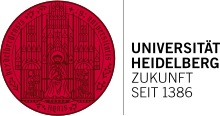
Back Ruprecht-Karls-universiteit Afrikaans Ruprecht-Karls-Universität Heidelberg ALS جامعة هايدلبرغ Arabic جامعة هايدلبرج ARZ Universidá de Heidelberg AST Heydelberq Universiteti Azerbaijani هایدلبرگ بیلیم یوردو AZB Univérsitas Heidelberg BAN Гайдэльбергскі ўніверсітэт Byelorussian Гайдэльбэрскі ўнівэрсытэт BE-X-OLD
Ruprecht-Karls-Universität Heidelberg | |
 Seal of the Ruperto Carola Heidelbergensis | |
| Motto | Semper apertus (Latin)[1] |
|---|---|
Motto in English | Always open |
| Type | Public |
| Established | 18 October 1386 |
| Budget | €764.9 million (2018)[2] |
| Chancellor | Holger Schroeter |
| President | Bernhard Eitel |
Administrative staff | 8,397[3] |
| Students | 28,653 (WS2019/20)[4] |
| Undergraduates | 15,289[5] |
| Postgraduates | 11,871[5] |
| 3,024[5] | |
| Location | , , 49°24′37″N 8°42′23″E / 49.41028°N 8.70639°E |
| Campus | Urban/University town and Suburban |
| Colors | Sandstone red and gold |
| Website | uni-heidelberg |
 | |
| Data as of 2013[update] | |
Heidelberg University is a public research university in Heidelberg, Baden-Württemberg, Germany.
It was founded in 1386 on the instructions of Pope Urban VI.[6] Heidelberg is Germany's oldest university, and is one of the world's oldest surviving universities. It was the third university established in the Holy Roman Empire. Prague (1348) and Vienna (1365) were at that time also German-speaking universities. The University of Vienna still is. Irrespective of the shared language of instruction, Heidelberg is the oldest university in modern Germany.
At the beginning, there were only the four traditional faculties. In 1890, the natural science got their own faculty.[6] Later after a re-organisation, the university has 12 faculties.
The University of Heidelberg is also known as Ruprecht Karl University of Heidelberg, after the German prince Rupert I.[7]
- ↑ "Mission Statement". uni-heidelberg.de. Retrieved 13 April 2017.
- ↑ "Daten und Fakten – Finanzen". Universität Heidelberg. Retrieved March 26, 2020.
- ↑ "Daten und Fakten - Personal". Universität Heidelberg. Retrieved March 26, 2020.
- ↑ "Kennzahlen Studium – Studierende und Wissenschaftlicher Nachwuchs". Universität Heidelberg. Retrieved March 26, 2020.
- ↑ 5.0 5.1 5.2 "Studierendenstatistik WS 2012/2013" (PDF). www.uni-heidelberg.de (in German).
- ↑ 6.0 6.1 "History of the Heidelberg University" (in German). University of Heidelberg. Retrieved 2009-11-13.
- ↑ German: Ruprecht-Karls-Universität Heidelberg Latin: Universitas Ruperto Carola Heidelbergensis